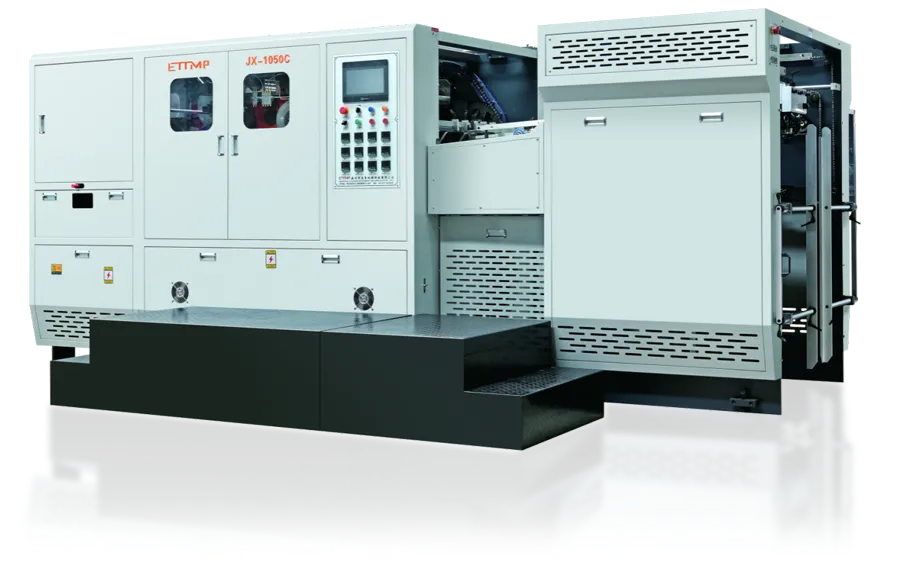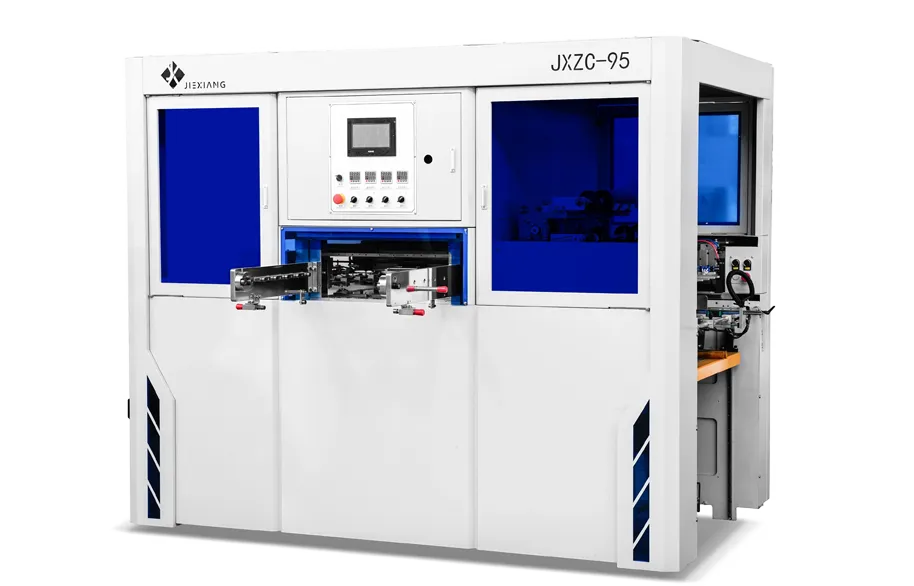Abstract: This comprehensive guide provides an in-depth, multi-dimensional analysis for international buyers navigating the procurement process for Automatic Foil Hot Stamping Machines. It segments buyers by business scale and need, guiding them through the pre-purchase, purchase, and post-purchase stages. The guide combines macro-industry insights with specific technical parameters, practical procurement advice, and strategic considerations, empowering buyers to make informed, cost-effective, and future-proof investment decisions. It is designed to be an authoritative yet accessible resource, ensuring clarity and actionable intelligence throughout the procurement journey.
Introduction
The Automatic Foil Hot Stamping Machine is a cornerstone of modern finishing and decoration across diverse industries, including packaging, printing, labeling, cosmetics, pharmaceuticals, and luxury goods. It elevates product aesthetics by applying metallic foils, pigments, or holographic effects with precision and efficiency. For international buyers, procuring such specialized equipment involves navigating a complex landscape of technologies, suppliers, and operational requirements. A misguided purchase can lead to significant financial loss, production bottlenecks, and compromised product quality.
This guide deconstructs the procurement process into a logical, step-by-step framework. By understanding buyer profiles, industry dynamics, technical specifications, and lifecycle management, you can transform a capital expenditure into a strategic asset that drives your competitive advantage.
Part 1: Understanding the Buyer Landscape - A Multi-Tiered Perspective
Not all buyers have the same requirements. The first step is to identify which category your organization falls into, as this will dictate your priorities.
Tier 1: Large-Scale Manufacturers & OEMs (Original Equipment Manufacturers)
-
Profile: High-volume production facilities, often running 24/7. They require machines for mass production of items like cigarette packs, liquor boxes, pharmaceutical cartons, or consumer electronics packaging.
-
Key Priorities:
-
Maximum Uptime & Reliability: Machines must be industrial-grade with minimal maintenance requirements.
-
High Speed & Automation: Speeds exceeding 7,000 sheets per hour (sph) and integration with upstream/downstream production lines (e.g., die-cutters, folders gluers) are critical.
-
Precision & Consistency: Exceptional registration accuracy (±0.1 mm or better) for multi-color or multi-process jobs.
-
Advanced Features: CNC servo-driven systems for quick job changeovers, touch-screen PLC controls with job memory, and sophisticated foil-saving mechanisms.
-
Total Cost of Ownership (TCO): Focus on long-term ROI, energy consumption, and service support over initial purchase price.
-
-
Budget: Premium ($80,000 - $500,000+).
Tier 2: Medium-Sized Printers & Specialized Converters
-
Profile: Businesses handling diverse, short-to-medium run jobs. They serve a broad client base requiring high-quality finishing for brochures, book covers, labels, and mid-range packaging.
-
Key Priorities:
-
Versatility & Flexibility: Ability to handle a wide range of substrates (paper, cardboard, plastic, leather) and sheet sizes.
-
Ease of Use & Quick Makeready: Operator-friendly interfaces and semi-automatic or automatic settings to reduce setup time and skilled labor dependency.
-
Good Value & Performance: A balance between speed (3,000 - 6,000 sph), precision, and cost.
-
Strong After-Sales Support: Accessible technical support and spare parts availability are crucial.
-
-
Budget: Mid-Range ($30,000 - $100,000).
Tier 3: Small Workshops, Start-ups, & Specialty Boutiques
-
Profile: Small businesses, artisans, or print-on-demand services focusing on low-volume, high-value products like wedding invitations, business cards, leather goods, or specialty labels.
-
Key Priorities:
-
Affordability & Low Initial Investment: Capital expenditure is a primary constraint.
-
Simplicity & Compact Design: Easy to install and operate in limited space, often by the business owner.
-
Sufficient Quality: The machine must produce clean, consistent results for discerning clients, even at lower speeds.
-
Basic Functionality: Manual or semi-automatic machines are common. Features like a heated foil saving system are a bonus.
-
-
Budget: Entry-Level ($5,000 - $30,000).
Part 2: The Procurement Lifecycle - A Stage-by-Stage Guide
Stage 1: Pre-Purchase Assessment & Strategic Planning
This is the most critical phase, determining the success of your entire investment.
1.1. Internal Needs Analysis:
-
Substrate Analysis: What materials will you stamp? (e.g., coated paper, uncoated paper, PVC, PET, synthetic leather). The material determines the required stamping pressure and temperature range.
-
Application & Foil Type: What effects are needed? (e.g., metallic gold/silver, pigment, gloss, matte, holographic, scratch-off). Different foils have different adhesive activation temperatures.
-
Production Volume & Run Lengths: Estimate daily/monthly output and average job size. This dictates the required speed and automation level.
-
Maximum Sheet Size & Stamping Area: Determine the largest material size you need to process and the maximum stamping area per impression.
-
Future-Proofing: Consider potential business growth or diversification. Is it worth investing in a slightly larger or more capable machine now?
1.2. Market Research & Supplier Identification:
-
Global Supply Landscape: The market is dominated by German, Italian, Japanese, and Chinese manufacturers. Each offers different value propositions.
-
European (e.g., Bobst, Gietz): Premium technology, exceptional precision, high speed, and a high price tag. Ideal for Tier 1 buyers.
-
Chinese & Taiwanese (e.g., JIEXIANG, YOCO): Offer a wide range from affordable entry-level to robust high-performance models. They represent the best value-for-money for Tiers 2 and 3, and increasingly for Tier 1 with their high-end offerings. A brand like JIEXIANG, for instance, has built a reputation for providing reliable machines with a good feature set at a competitive price point, making them a strong contender for international buyers seeking balance.
-
-
Evaluation Criteria for Suppliers:
-
Company History & Reputation: How long have they been in business? Look for customer testimonials and case studies.
-
Technical Expertise: Do they have R&D capability? Can they provide custom solutions?
-
International Sales & Support Network: Is there a local distributor or agent for spare parts and service? What are the response times for support?
-
Stage 2: The Purchase Process - Technical Deep Dive & Negotiation
2.1. Core Technical Specifications to Scrutinize:
-
A. Drive System (The Heart of the Machine):
-
Fully Servo-Driven: The gold standard. Uses servo motors for head movement, foil feeding, and table elevation. Offers superior precision, faster setup, quieter operation, and lower mechanical wear. Essential for Tier 1, highly recommended for Tier 2.
-
Pneumatic-Driven: Uses air pressure. Less precise, noisier, but more affordable. Common in entry-level machines.
-
Mechanical-Driven: Traditional cam-driven systems. Very robust for high-speed applications but less flexible.
-
-
B. Control System (The Brain):
-
PLC (Programmable Logic Controller) with Touch-Screen HMI: Allows for digital input of all parameters (temperature, pressure, dwell time), job storage, and diagnostics. Look for an intuitive interface.
-
CNC (Computer Numerical Control): Advanced feature for automatically setting the stamping position and repeat length, drastically reducing makeready time.
-
-
C. Performance Parameters:
-
Maximum Speed: Measured in impressions per hour (iph) or sheets per hour (sph). Understand the difference between technical maximum and practical production speed.
-
Printing Accuracy (Registration): The repeatability of the stamping position. Look for figures like ±0.1 mm. This is critical for multi-pass stamping.
-
Stamping Pressure: Measured in tons or kilonewtons (kN). Ensure it's sufficient for your thickest substrates and deepest embossing needs.
-
Temperature Control Range: Typically 0-300°C. Precise and stable temperature control (±1°C) is vital for consistent foil transfer.
-
-
D. Key Features for Efficiency & Cost-Saving:
-
Foil Saving System: A device that separates the foil carrier from the stamped design between impressions, reducing foil waste by up to 30%. A must-have for cost-sensitive applications.
-
Automatic Waste Rewind: Automatically winds up the used foil carrier for clean and efficient operation.
-
Programmable Dwell Time: Controls how long the stamping head remains in contact with the substrate, crucial for complex materials.
-
2.2. The Quotation & Negotiation Phase:
-
Request a Detailed Quotation (Proforma Invoice): It should itemize the machine price, standard accessories, optional accessories, shipping terms (Incoterms 2020), payment terms, and delivery lead time.
-
Clarify "Standard" vs. "Optional": What is truly included? Common extras include: additional stamping heads, embossing attachments, UV coating units, specific feeding systems, and extra foil rewind shafts.
-
Negotiate on Value, Not Just Price: Discuss payment terms (e.g., 30% deposit, 70% before shipment), warranty extension, inclusion of training, or a discount on initial spare parts.
2.3. Factory Audit & Sample Testing (Highly Recommended):
-
Virtual or On-Site Audit: Request a live video demonstration of the exact machine model. For large investments (Tier 1), an on-site visit is invaluable to assess manufacturing quality and technical capability.
-
Provide a Sample for Testing: Send your actual substrate and foil to the supplier. Have them run a production sample and send it back for your evaluation. This is the ultimate test of the machine's suitability.
Stage 3: Post-Purchase - Installation, Operation, & Long-Term Management
The relationship with the supplier only intensifies after the sale.
3.1. Shipping & Logistics:
-
Understand Your Incoterms: Know your responsibilities and risks. FOB (Free On Board) is common, meaning the supplier is responsible until the goods are loaded on the ship. For simpler logistics, consider CIF (Cost, Insurance, and Freight).
-
Professional Freight Forwarder: Use an experienced forwarder who handles heavy machinery. Ensure proper crating and insurance.
3.2. Installation & Commissioning:
-
Site Preparation: Ensure the floor can support the machine's weight, and that you have the correct power supply (voltage, phase, frequency) and compressed air source.
-
Supervision: The supplier should provide installation guidance, either by sending an engineer or via detailed remote support. Be prepared to cover the engineer's travel and accommodation if not included.
3.3. Training & Documentation:
-
Comprehensive Training: Insist on thorough training for your operators and maintenance technicians. This should cover daily operation, routine maintenance, basic troubleshooting, and safety procedures.
-
Quality of Manuals: Request manuals in your preferred language (English is standard), with clear diagrams, parts lists, and troubleshooting guides.
3.4. After-Sales Service & Spare Parts:
-
Warranty Period: Typically 12 months. Understand what is covered (parts, labor) and what is not (consumables, damage from misuse).
-
Technical Support Channels: Confirm the availability of remote support (WhatsApp, Skype, TeamViewer) and its hours of operation relative to your time zone.
-
Spare Parts Availability: Ask for a recommended spare parts list (e.g., heating elements, sensors, fuses) and ensure there is a reliable system for ordering and shipping them quickly.
3.5. Maintenance & Lifecycle Optimization:
-
Implement a Preventive Maintenance (PM) Schedule: Follow the supplier's PM checklist religiously. This includes daily cleaning, weekly lubrication, and monthly inspections. This is the single most important factor for maximizing machine lifespan and preventing costly downtime.
-
Keep Records: Maintain logs of maintenance activities, foil usage, and any breakdowns. This data is invaluable for troubleshooting and future procurement decisions.
Part 3: Macro Industry Trends Impacting Your Purchase Decision
-
Sustainability: Growing demand for eco-friendly foils (recyclable, biodegradable) and energy-efficient machines. Servo-driven machines have a clear advantage here.
-
Digitalization & Industry 4.0: High-end machines now offer IoT capabilities for real-time monitoring of production data, predictive maintenance alerts, and integration into MIS (Management Information Systems).
-
Short Runs & Customization: The market is shifting towards smaller, personalized batches. This increases the importance of quick job changeovers and versatile machines.
-
Hybrid Printing: Combining foil stamping with other processes like digital printing in a single line is a growing trend, offering unparalleled design possibilities.
Conclusion
Procuring an Automatic Foil Hot Stamping Machine is a significant strategic decision. By meticulously following this guide—defining your needs as a Tier 1, 2, or 3 buyer, rigorously evaluating technical specifications during the purchase phase, and establishing a robust plan for installation, training, and maintenance—you can navigate the global market with confidence. The goal is not merely to buy a machine, but to secure a productive asset that will enhance your product quality, improve your operational efficiency, and strengthen your market position for years to come. Remember, the cheapest option is rarely the most cost-effective when considering the total cost of ownership and the critical role this machine plays in your final product's appeal.
This article is generated with AI assistance to ensure data accuracy and comprehensive scope, and is carefully reviewed and refined by machinery industry experts to provide actionable insights.













